Speech The Usual Transmission – Monetary Policy and Financial Conditions

Christopher Kent[*]
Assistant Governor (Financial Markets)
Address to Finance & Treasury Association
Sydney –
Introduction
I'd like to start by thanking the Finance and Treasury Association for the opportunity to speak to you today about the transmission of monetary policy.
In my current position at the Reserve Bank I oversee the Financial Markets Group. Among other things, we spend our time analysing financial market developments, around the globe and in Australia. A key task is to consider the ways in which monetary policies are affecting economic developments. The first stage of that transmission is the effect of policies on financial conditions. The second stage of transmission – which I won't address today – is how those financial conditions then influence business and household decisions regarding investment and consumption, and the size and nature of their balance sheets.
The first two years or so in my current position were characterised by a degree of stability in financial markets.[1] Taking just one example, 10-year government bond yields, which had increased through 2016 were moving in a relatively narrow range over most of 2017 and 2018 (Graph 1). Yields were drifting a little higher in the United States, to just above 3 per cent, they were stable within the range of 2.5 to 3 per cent in Australia, much lower than that but still positive and stable in Germany, and little changed around zero in Japan.
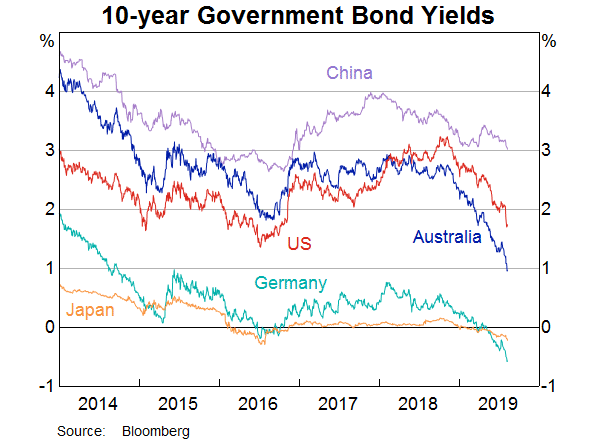
Meanwhile, stimulatory monetary policies were gaining traction. Spare productive capacity in economies was being absorbed, with unemployment rates declining to relatively low levels and wages growth gradually picking up in a wide range of advanced economies. In a number of advanced economies – with inflation at, or close to targets – central banks were removing some stimulus. Most notable was the US Federal Reserve, but it was not alone in raising its policy rate (Graph 2). Moreover, market pricing suggested that monetary policies in a broader range of advanced economies – including in Australia – were more likely to be tightened rather than eased, even if that prospect was still some way off.
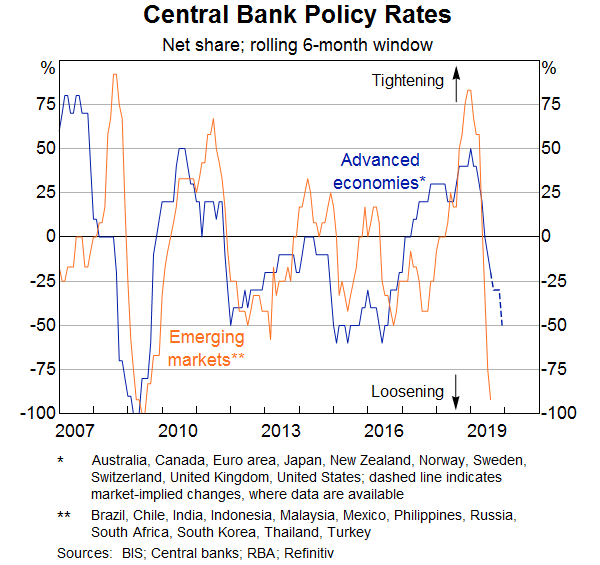
Through 2018, higher US interest rates were placing some external financing pressure on a number of emerging market economies (EMEs), particularly those that had unhedged exposures to US dollar debts. Partly in response, a large share of EME central banks had raised their policy rates over the second half of that year.
That global picture of steady improvement in economic conditions and gradual removal of monetary stimulus has changed significantly since late last year. Just a couple of weeks ago, the US Federal Open Market Committee (FOMC) reduced the federal funds rate. The Reserve Bank of Australia has also reduced the overnight cash rate in recent months, as has the Reserve Bank of New Zealand. Moreover, market pricing implies that a number of central banks in advanced economies are expected to reduce policy rates in the coming months. Central banks in a large share of EMEs have also reduced their policy rates.
In the rest of my presentation, I will outline some reasons for this change in the stance of monetary policies. I'll then turn to the response of financial markets to those changes, with a focus on some of the key aspects of the transmission to financial conditions in Australia.
The Changing Stance of Monetary Policies
The market's view of the likely course of monetary policies in the major advanced economies has changed noticeably in just the past few months (Graph 3).
Two weeks ago, the US FOMC reduced the fed funds rate by 25 basis points. At the same time, the Chair of the FOMC emphasised that the US economy remains strong, and that the policy easing should be viewed as a ‘mid-cycle adjustment’. In other words, more of a course correction than a reversal of course. The FOMC emphasised that it was responding to subdued inflation and the downside risks to the outlook for US economic activity. The FOMC also noted the easing in global growth, reflected most recently in a softening in business investment. Given all of this, and the recent ratchetting up of the US–China dispute,[2] market pricing currently suggests that the Fed is expected to lower its policy rate by a further 100 basis points by around this time next year.
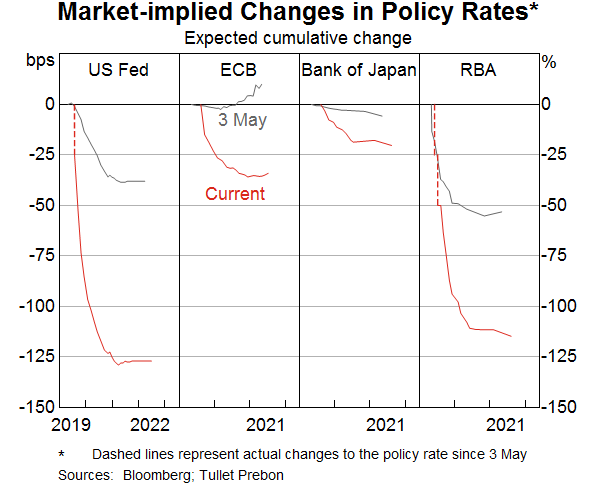
While US economic growth has held up reasonably well, growth in the euro area has slowed more noticeably. At its recent meeting, the European Central Bank (ECB) emphasised that it will provide additional stimulus in the absence of a further improvement in the outlook for inflation, which has averaged under 1 per cent for the past few years, compared with the ECB's medium-term target of close to, but below, 2 per cent. Should further stimulus be necessary, the ECB noted that it could lower its policy rate, strengthen its guidance on the future path of policy, and resume the expansion of its balance sheet (by purchasing additional government and private sector securities). Market analysts expect a package of such measures to be announced in September. And market pricing now implies that the ECB is expected to reduce its policy rate further into negative territory, from −40 basis points currently to −60 basis points by the end of this year.
Meanwhile, the Bank of Japan (BoJ) recently emphasised that it will consider additional easing measures ‘… if momentum towards achieving …’ its inflation target were to be lost. Accordingly, market participants expect that the BoJ will lower its policy rate by 10 basis points to −20 basis points before the end of the year.
Given increasing concerns about downside risks to growth around the world, and generally subdued inflation pressures, market pricing implies that policy rates are expected to be lowered in a number of other advanced economies.
In Australia, with growth having slowed to a below-trend pace and inflation pressures subdued, the Board of the Reserve Bank reduced the cash rate at its June and July meetings. The Board noted that, although employment growth remained strong, there had been little inroad made into spare capacity in the labour market recently, with the unemployment rate having risen slightly. Financial market prices currently imply that the cash rate is expected to be reduced by a further 25 basis points later this year and then again in the first half of next year.
The Response of Financial Markets Globally
Towards the end of 2018, trade disputes were weighing on manufacturing, trade and business confidence around the globe. A broader easing in the pace of economic growth in some economies was also emerging, including in Europe and China. Financial markets responded to those developments, and rising concerns about the downside risks to the global outlook in an environment of subdued inflation. Of particular note, longer-term interest rates turned down.
Those declines were extended more recently as the market reassessed the outlook for monetary policies as well as the outlook for growth in light of ongoing downside risks. With expectations that policies are likely to be more stimulatory than earlier anticipated, and with inflationary pressures remaining subdued, interest rates right along the yield curve have declined noticeably over the past year (Graph 4). Yields at 10 years are back below 2 per cent in the United States, and are at historic lows elsewhere, including in Germany, where 10-year yields are trading at close to −60 basis points. Rates in Japan have moved by less, which appears to reflect the market expectation that the BoJ is not likely to provide significant additional stimulus. Most notably though for this audience, the Australian yield curve has shifted down more so than in these other economies over the past year.
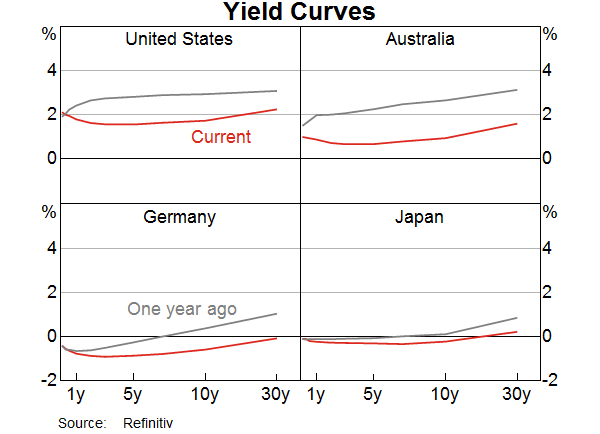
As well as helping to reduce risk-free rates, the effect of the easier stance of monetary policies is evident in other financial markets. Corporate bond yields have declined this year (Graph 5). This reflects both lower government bond yields and lower corporate bond spreads. One possible interpretation of the low level of corporate bond spreads is that investors' concerns about corporate defaults are about as low as they have been for quite a few years. That is somewhat at odds though with significant concerns about downside risks to global growth. So it's possible that market participants are placing considerable faith in the willingness and ability of central banks to respond to adverse shocks. Alternatively, record low risk-free rates may be encouraging investors to search for yield, and so they may be underappreciating and underpricing the risks to corporate earnings.
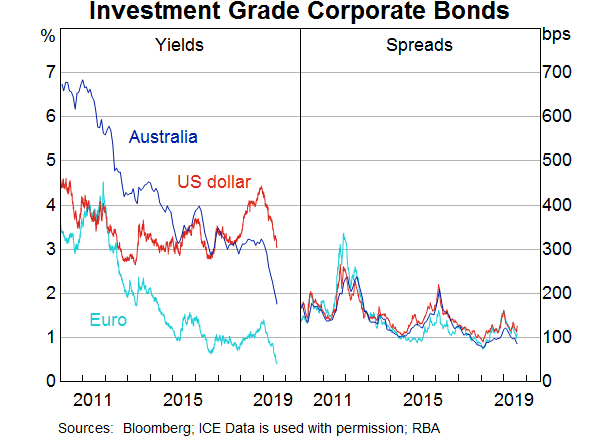
Also, for much of this year, equity prices have been supported by the effect of the changing stance of monetary policies on sovereign bond yields (Graph 6). In part, this reflects the rise in the discounted value of future corporate earnings arising from lower risk-free rates. At the same time, market analysts still expect good growth in earnings next year, despite some slowing in earnings growth this year and notwithstanding rising downside risks to global growth. Again, this suggests that participants judge that adverse shocks to growth are either likely to have only a modest effect on corporate earnings, and/or that policy accommodation will help to mitigate the effects of any adverse shocks to growth. However, as seen during the recent ratchetting up in the US–China dispute, asset prices could fall quickly if market participants become more concerned about its potential to weigh on growth of the global economy and corporate earnings.
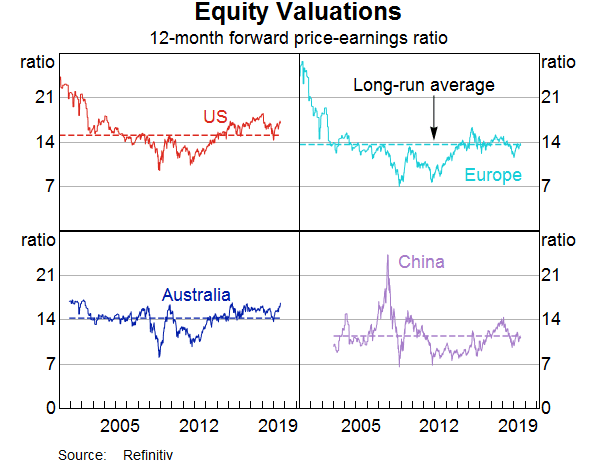
The combination of all of these changes has underpinned a general easing in global financial conditions through the course of this year.
Changes in Australian Financial Conditions
The transmission to Australian financial conditions of easier monetary policy both here and globally can be traced through the effects on funding costs, and on the Australian dollar.[3]
Funding costs – banks, businesses and households
The recent reductions in the overnight cash rate in Australia – and the decline in interest rates right along the yield curve – have reduced the costs of funding to historical lows for banks, businesses and households.
Banks' funding costs have declined across the board (Graph 7). The cost of funding in short-term money markets has declined noticeably this year. Much of the fall follows from the decline in the cash rate and the anticipation of a further decline over the coming months – as captured by the rate for the overnight indexed swaps, or OIS for short.
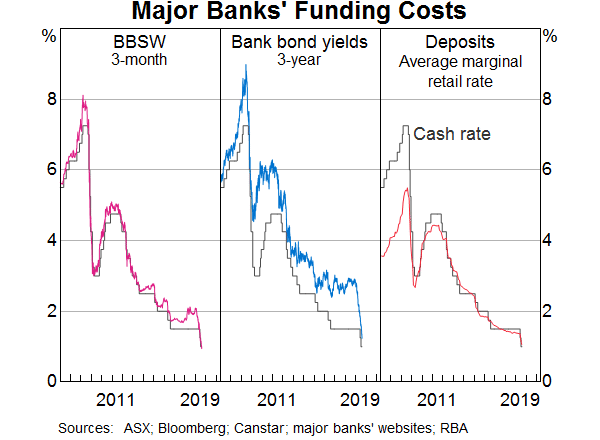
But in addition to the change in the stance of monetary policy, the spread of the 3-month bank bill swap (BBSW) rate to OIS has declined this year, more than unwinding the increase seen in 2018 (Graph 8). Indeed this spread has declined to its lowest level in many years.
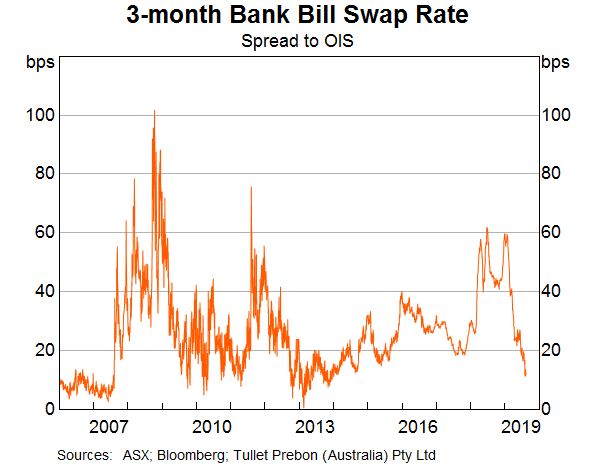
Yields on the major banks' bonds have declined in response to both lower risk-free yields and a decline in the spreads of bank bonds to these reference rates.
Also, banks have passed through most of the cash-rate reductions to interest rates on retail deposits, which account for about a third of their debt funding. As is typical, the interest rates on transaction accounts (which are at or close to zero) have not been changed following the reductions in the cash rate. However, these account for only a small share of the total value of the banks' retail deposits.[4] Other at-call deposit rates are estimated to have been lowered by 40−45 basis points, while interest rates on term deposits have fallen significantly over recent months.
The banks have passed on these lower costs of funds to borrowers. Interest rates on loans to large businesses – the bulk of which are closely tied to BBSW rates – have declined over recent months to very low levels (Graph 8). Lending rates on outstanding loans to small businesses decreased by around 20 basis points following the reduction in the cash rate in June (the latest data available). Small business lending rates remain noticeably higher than interest rates for large businesses. This partly reflects the higher default rates associated with small business loans.
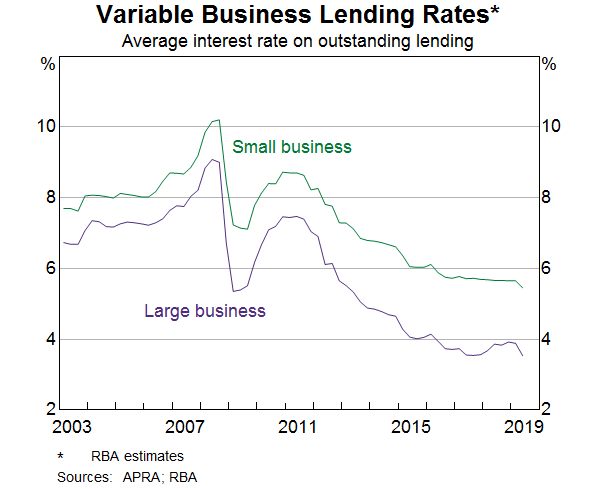
Lenders have passed through most of the cash rate reductions to housing interest rates. Following the 50 basis point reduction in the cash rate from June to July, lenders lowered their standard variable rates (SVRs) on housing loans by an average of 44 basis points (Graph 10). The extent of pass-through was broadly consistent with the experience of the past decade.
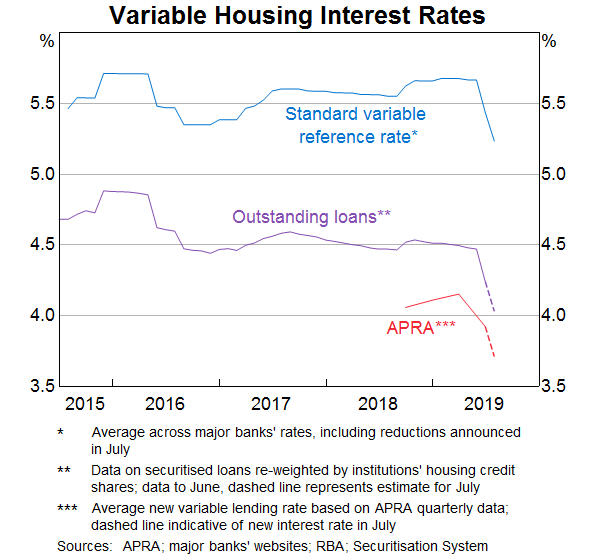
The average interest rate actually paid on outstanding variable-rate housing loans in the Reserve Bank's Securitisation Dataset decreased by 23 basis points in June, the same as the average announced reduction in SVRs. Similar reductions in outstanding rates are expected to be recorded for July data. So the declines in SVRs are being pushed through to all existing borrowers, which make up the so called ‘back book’. Rates on new loans have also been lowered. Indeed, new borrowers, and those refinancing existing loans, continue to be offered interest rates that are on average well below those applying to existing loans. So customers who are actively looking around at what's on offer, are able to take advantage of the strong competition among lenders that is focused squarely on the ‘front book’.
Meanwhile, interest rates on fixed-rate housing loans have also declined significantly over recent months.
Although housing credit growth declined further in June, approvals for new loans increased. This increase in approvals was broadly based, across owner-occupiers and investors, across states and across different types of lenders. It was also consistent with the improved conditions in housing markets evident in a range of indicators, such as auction clearance rates and housing price growth, particularly in New South Wales and Victoria.[5] If housing conditions continue to improve in the coming months, we would expect to see a further rise in loan approvals.
The Exchange Rate
Finally, I'll say a few words about the exchange rate, given that it is an important part of the transmission of monetary policy. In trade-weighted terms, the Australian dollar has declined by about 7 per cent over the past year or so and is now lower than it has been for many years (Graph 11).

While commodity prices have declined more recently, they had trended higher over much of the past year when the exchange rate had been depreciating. But that earlier rise in commodity prices may have been less supportive for the exchange rate than in the past for a number of reasons.[6] First, at least some of increase in commodity prices over the past year had been expected to be short lived, given that was driven by supply disruptions. Second, the rise in commodity prices over the past year or so was likely to have been seen as less expansionary than in the past. Certainly, it is unlikely to have supported a boom in mining investment of the like seen a few years ago.[7] Third, the positive effect of the upward trend in commodity prices on the exchange rate might have been partly offset given downside risks to the outlook for the Chinese economy that could weigh on demand for Australian goods and services outside of resources (such as education and tourism, for example). Despite these possibilities, the upward trend in commodity prices was still likely to have provided some support to the value of the Australian dollar over much of the past year or more.
Despite that support, the Australian dollar had depreciated over that period when commodity prices had been rising. That implies that the effect of monetary policy on the exchange rate has been broadly working as usual. As I mentioned before, there has been a noticeable decline in Australian interest rates relative to those of major advanced economies. At a two-year horizon, this interest rate differential has declined by about 100 basis points over the past year. This lower return on Australian assets would no doubt have contributed to a decline in the value of the Australian dollar.
Conclusion
Bringing all of this together, I draw the conclusion that the transmission of monetary policy in Australia to financial conditions is working in the usual way. In particular, the change in the stance of policy has underpinned the decline in risk-free rates along the yield curve. It has also contributed to a decline in the cost of funding in corporate bond markets, supported equity prices, and lowered the cost of funding for banks, including through lower rates on bank deposits. Much of the reduction in banks' funding costs has been passed through to business and household borrowers. And notwithstanding an easier stance of monetary policy globally, the decline in interest rates in Australia has contributed to the depreciation of the Australian dollar. That broad-based easing in financial conditions in Australia will provide some additional support to demand in the period ahead.
Endnotes
I thank Max Wakefield for valuable assistance in preparing this material. [*]
See Debelle G (2018), ‘Risk and Return in a Low Rate Environment’ Speech at Financial Risk Day, Sydney, 16 March. [1]
For a more detailed discussion of the implications of this and other trade disputes for the economic outlook see Debelle G (2019), ‘Risk to the Outlook’, speech at the 14th Annual Risk Australia Conference, Sydney, (upcoming). [2]
While global developments influence Australian financial conditions, changes in monetary policy settings elsewhere need not, and do not, mechanically feed through to the funding costs of Australian banks. For a further discussion of this point, see Kent C (2018), ‘US Monetary Policy and Australian Financial Conditions’, The Bloomberg Address, Sydney, 10 December. [3]
As of June, retail deposits paying no interest accounted for a little under 10 per cent of the value of the major banks' retail deposits. The share of deposits that paid some interest, but less than 50 basis points, was also a little under 10 per cent in June (up from around 5 per cent of deposits in February). See RBA (Reserve Bank of Australia) (2019), Statement on Monetary Policy, August, viewed 9 August 2019. Available at https://www.rba.gov.au/publications/smp/2019/aug/>. [4]
RBA (2019), Statement on Monetary Policy, August, viewed 9 August 2019. Available at https://www.rba.gov.au/publications/smp/2019/aug/. [5]
Chapman B, J Jaaskela and E Smith (2018), ‘A Forward-looking Model of the Australian Dollar’, RBA Bulletin, December, viewed 9 August 2019. Available at <https://www.rba.gov.au/publications/bulletin/2018/dec/a-forward-looking-model-of-the-australian-dollar.html>. [6]
RBA (2019), ‘Box B: The Recent Increase in Iron Ore Prices and Implications for the Australian Economy’, Statement on Monetary Policy, August, pp 37–40. [7]